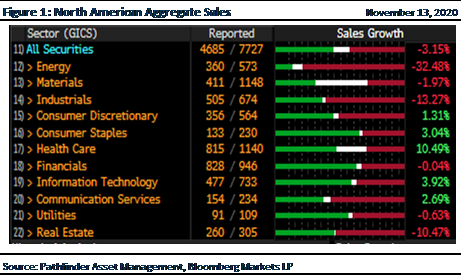The US Election, Government Fiscal Response & Earnings
We previously wrote (PIO Vol 10 Ed 33) about the United States Federal Open Market Committee (FOMC) and its waning ability to impact the business cycle. We believe more fiscal stimulus will be required to avoid a further recession. Fiscal stimuli are government policy measures that typically increase spending to boost economic activity. Because of the nature of politics, it tends to be controversial (design and implementation) and limited by political will, the efficiency of the program and the ability of the government to borrow capital from financial markets. Policy has essentially infinite possibilities, only limited by the creativity of legislators – decreasing taxes, providing government credit for certain types of industry, mailing cheques directly to citizens, public works (i.e. Hoover Dam, National Highway System, Landing on the Moon) or other types of programming that use government borrowing to transfer assets to citizens through direct deposit or work projects. The effectiveness of each of these vary, as does the ability and will to implement. This week, we debated the potential of new fiscal measures along with their impact on our portfolios. We also reviewed and discussed how the current earnings season has been progressing. We are almost two thirds of the way though, so a short update is in order.
- Figure 1 is the regular earnings analysis table that long-time readers of the Investment Outlook will recognize. So far 61% of North American companies have reported and, as you can see, even with increased traffic and continued government support, overall sales fell again this quarter (third quarter in a row). This time by 3.2%. The pain is still quite broad. We met yesterday (virtually) with the management of Brixmor Property Group (BRX:US), a large US outdoor shopping center company. They have been surprised by the staying power of their tenants, but it was clear from them that more stimulus is needed to avoid economic difficulty in the coming months, as small businesses struggle to keep operating at breakeven levels.

“This means that” we have been long-term skeptics of the government’s ability to execute efficient fiscal policy. We did not comment on the US election last week as it was not called by the Associated Press until Saturday. However, given the $2 trillion infrastructure plans presented by President-Elect Biden, and the runoff that will be required for 2 US Senate seats in Georgia (this will determine if Vice President-Elect Harris will have the tiebreaking Senate vote), the potential for the new administration to implement big fiscal stimulus remains unclear. We will watch the coming vote carefully but in reality, nothing will be passed until February if it is not passed by the current administration.
National Instrument 31-103 requires registered firms to disclose information that a reasonable investor would expect to know, including any material conflicts with the firm or its representatives. Doug Johnson and/or Pathfinder Asset Management Limited are an insider of companies periodically mentioned in this report. Please visit www.paml.ca for full disclosures.
*All returns are time weighted and net of investment management fees. Returns from the Pathfinder Partners’ Fund and Pathfinder Real Fund are presented based on the masters series of each fund. The Pathfinder North American Equity Portfolio and The Pathfinder North American Income Portfolio are live accounts. These are actual accounts owned by the Pathfinder Chairman (Equity) and client (High Income) which contain no legacy positions, cash flows or other Pathfinder investment mandates or products. Monthly inception dates for each fund and portfolio are as follows: Pathfinder North American Equity Portfolio (January 2011), Pathfinder North American High-Income Portfolio (October 2012) Pathfinder Partners’ Fund (April 2011), Pathfinder Real Fund (April, 2013), and Pathfinder International Fund (November 2014).
Pathfinder Asset Management Limited (PAML) and its affiliates may collectively beneficially own in excess of 10% of one or more classes of the issued and outstanding equity securities mentioned in this newsletter. This publication is intended only to convey information. It is not to be construed as an investment guide or as an offer or solicitation of an offer to buy or sell any of the securities mentioned in it. The author has taken all usual and reasonable precautions to determine that the information contained in this publication has been obtained from sources believed to be reliable and that the procedures used to summarize and analyze such information are based on approved practices and principles in the investment industry. However, the market forces underlying investment value are subject to sudden and dramatic changes and data availability varies from one moment to the next. Consequently, neither the author nor PAML can make any warranty as to the accuracy or completeness of information, analysis or views contained in this publication or their usefulness or suitability in any particular circumstance. You should not undertake any investment or portfolio assessment or other transaction on the basis of this publication, but should first consult your portfolio manager, who can assess all relevant particulars of any proposed investment or transaction. PAML and the author accept no liability of any kind whatsoever or any damages or losses incurred by you as a result of reliance upon or use of this publication.